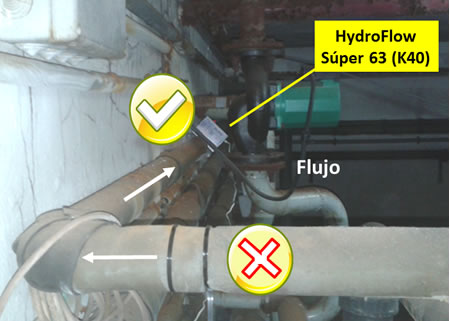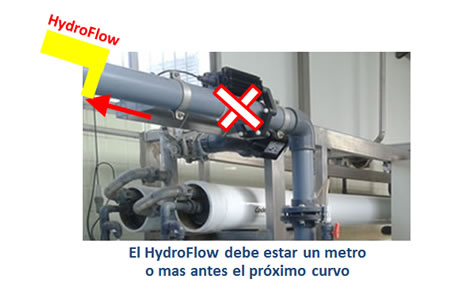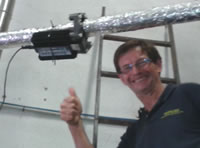This post is in English for general use.
Installation tips.
- For best signal
- Install on a stretch of straight pipe
- Install a metre or more before the next bend.
- Install after the filter (if there is one).
- Install after the pump (if there is one)

- For best flocculation
- Soon after the pump with a metre or more before the next bend. The longer the stretch of straight pipe the better. The HydroFlow below was installed by the client. It has since been repositioned to be much further away from the elbow in the pipe.

HydroFlow & Reverse Osmosis
- Soon after the pump with a metre or more before the next bend. The longer the stretch of straight pipe the better. The HydroFlow below was installed by the client. It has since been repositioned to be much further away from the elbow in the pipe.
- Hot water pipes
- Install a model bigger than the pipe requires.
- The ‘P’ range seems to be better with hot water
- Insert a wood insulation between the transducer and the pipe.
- Hang the unit upside down.
- Recommend that the insulation on metal pipes be enhanced with aluminium foil.
- Keep temperature of unit under 50 degrees. Use a fan if necessary
- Consider also installing on the cold water pipe

HydroFlow P100 en un tubo de 2 pulgadas
- Heat Exchangers
- Install a filter between the hot water accumulator and the heat exchanger to trap the limescale released by HydroFlow. this is important for plate heat exchangers.
- HydroFlow needs a stretch of straight pipe to establish the signals. The installation in the photo above was a partial success. For complete success in preventing incrustations of limescale, the piping needs to be adjusted to give ideally a metre of straight pipe between the HydroFlow and the heat exchanger.
- Old pipes
- To minimise the possibility of leaks, install a timer so that HydroFlow is not working all the time. This will mean there will always be some limescale on the pipes to seal potential leaks.
- To minimize white in the water of a swimming pool, a timer can be used for the first month, to control the dissolution of limescale in the pipes.
- Filters will be required to catch the flakes of limescale released by HydroFlow before the sensitive points – ie the water heater, the pump in the hot water system, the heat exchanger.
- Safety
- Make safe the transducer with plastic ties, before securing the unit with the metal ties.
- Add the ferrites when the transducer is secure.
- Use Loctite 243 to secure the plastic nuts and bolts of the ferrites, or
- Use washers, to prevent the ferrites from coming loose as a result of vibrations.
- You need two pairs of hands to install on a vertical pipe.
If you have anything to add, please comment or
email aguaeco at aguaeco.com
